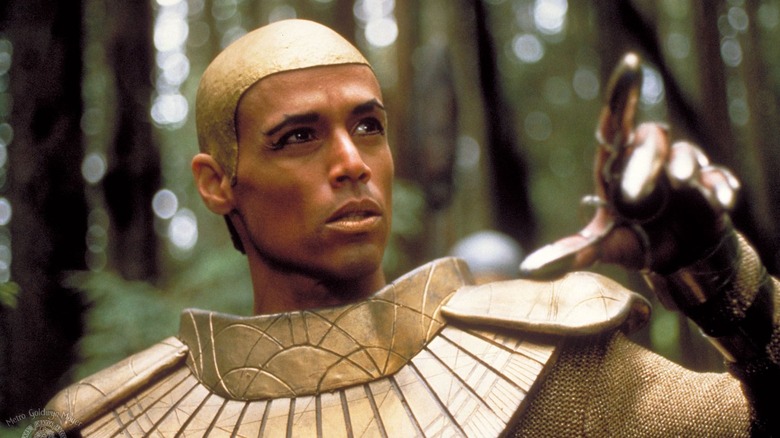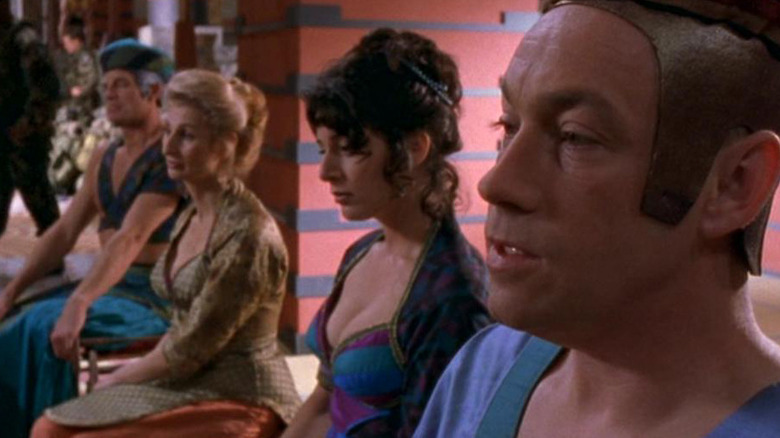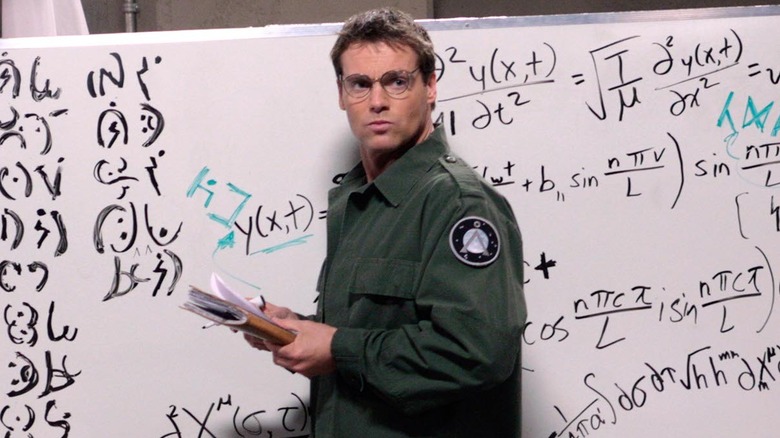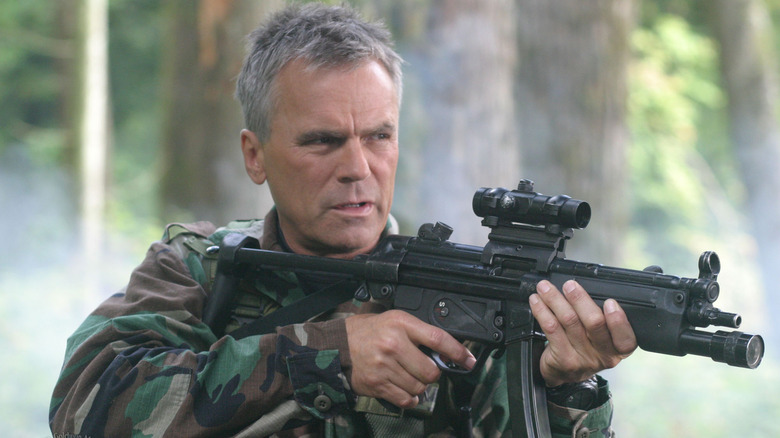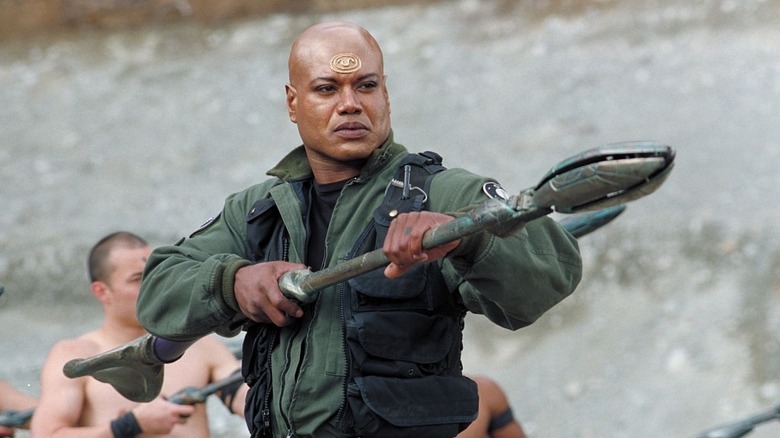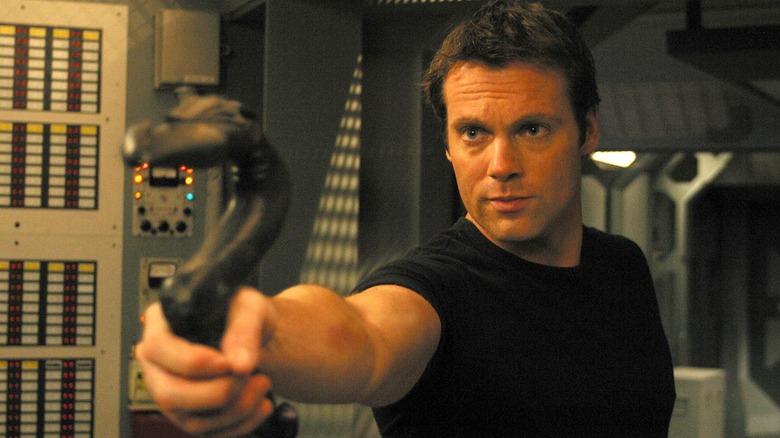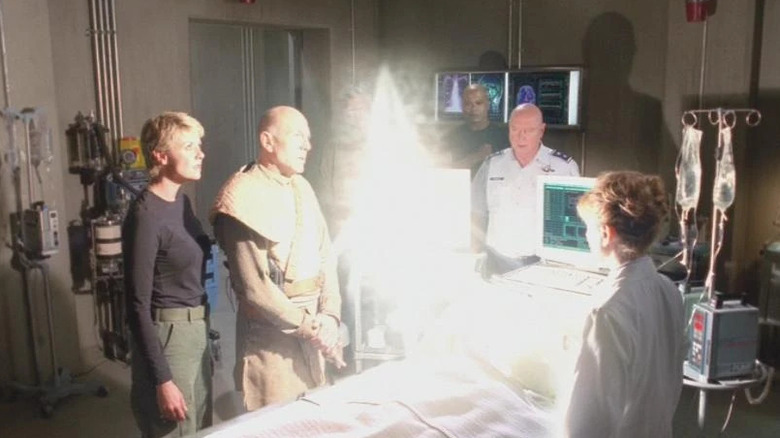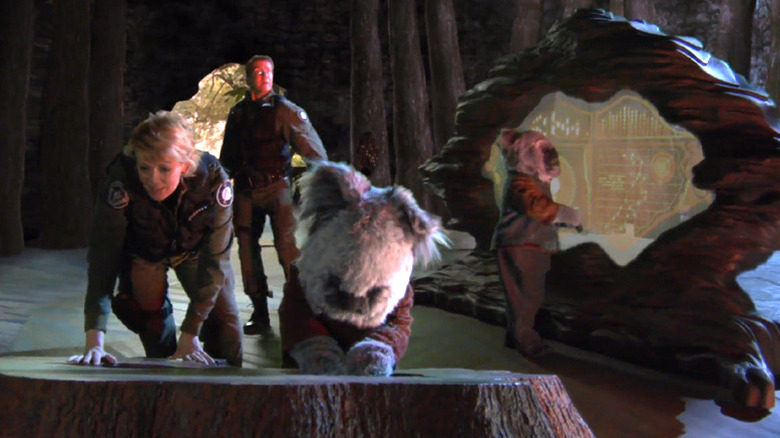Dumb Things We Just Ignore About Stargate
After the commercial success of the Roland Emmerich film "Stargate" in 1994, MGM decided to continue the "Stargate" franchise on the small screen, and that's how millions of sci-fi fans were introduced to the beloved series "Stargate: SG-1." The show made many changes to the premise and logic set out by the film: There was seemingly an acceptance that a certain amount of retconning was necessary in order to make a serialized story based on the movie work. That being said, "Stargate SG-1" (and the subsequent shows "Stargate: Atlantis" and "Stargate: Universe") allowed for plenty of plot holes and contrivances that have been known to frustrate some viewers even to this day. Yet, the "Stargate" fandom will still passionately defend the franchise, warts and all.
As far as the "Stargate" timeline goes, it works because there's a steadfast determination to accept (and sometimes embrace) the many inconsistencies and plain-old dumb ideas that will always come with a story that depends almost entirely on imagination and genre traditions. "Stargate: SG-1" doesn't hesitate to embrace its silliness — just look at Season 5, Episode 12, "Wormhole X-Treme!" — and often allows Colonel Jack O'Neill (Richard Dean Anderson) to voice necessary ridicule. There are dumb things in the "Stargate" franchise that fans will always talk about, but in a way, those things are just as much a part of what makes it so enjoyable.
Every planet looks like Canada
Many have watched "Stargate: SG-1" and pointed out that most of the planets trekked by the Stargate program's A-team (SG-1) closely resemble Canada. Of course, we all know the real-world reason for that: "Stargate: SG-1" was filmed in Vancouver for its entire run and there are only so many ways to make a place look like an entirely different world. In fact, John Gajdecki (who was the visual effects supervisor on the first two seasons of "Stargate: SG-1") and the rest of the VFX team worked hard to find alternative locations that were close enough to the show's sets and still looked interesting, but there was only so much they could do.
Speaking to The Companion, Gajdecki revealed that Hudson Hickman, MGM's Vice President of Physical Production, asked them to add more variation to the alien worlds they were visiting, which was easier said than done. "He basically said, 'Can we not go to the rainy forest planet anymore?' That's Vancouver in the winter. It just rains here," Gajdecki said. "We're always outside, always in the rain, because that was the weather at the time. And so we really started struggling to create locations that were not just in the forest."
While the team scouted locations that worked for settled planets like the Tollan homeworld and even found some cool outdoor filming sites nearby, like the sulfur pits that served as the landscape for P3X-562, SG-1 still mostly visited forested planets during the series. This does make some sense, considering the necessary parameters for human habitation (Goa'uld are the main gate-users when SG-1 starts adventuring and Goa'uld tend to inhabit human bodies), but it doesn't seem very plausible that so many faraway planets look like Canada.
Everyone speaks English
When "Stargate: SG-1" was on the air, it had about 45 minutes once a week to tell a compelling story about alien life, advanced technology, and interplanetary politics. This meant that accuracy-minded viewers (of which every sci-fi show has a substantial number) often needed to ignore one big issue that any team of space-traveling humans would face should they encounter sentient, alien life on another planet: Many viewers have pointed out how ridiculous it is that nearly every group of aliens SG-1 encounters speak English as a primary language. It's pretty dumb, but the truth is that "Stargate SG-1" simply did not have time for SG-1's resident translator, Doctor Daniel Jackson (Michael Shanks), to learn a new form of communication every episode.
Many of the "aliens" the team comes across are actually humans that were brought to another planet by ancient Goa'uld to serve as slaves, so you could argue that this explains English being widespread as well as the fact that the show's "aliens" usually look like humans. However, the Goa'uld didn't know of the English language until Earthlings made contact through gate travel, so they couldn't have compelled their slaves to learn the language. When "Stargate: Atlantis" premiered in 2004, the exploration team made contact with a race of humans who spoke fluent English, so it wasn't something specific to the Milky Way galaxy. There really isn't any good explanation for the galactic prevalence of English in the "Stargate" universe other than the fact that it made storytelling much easier.
Sam Carter is nearly every kind of scientist
Captain Samantha Carter (Amanda Tapping) is a brilliant astrophysicist and engineer who worked on the Stargate program and helped figure out how to use the gate to reach other planets. Throughout the course of "Stargate: SG-1," Sam becomes one of the most important people on Earth as a specialist in understanding alien technology both in a theoretical and practical context. It's already hard to believe that she's a specialist in all of those things alone, but "Stargate: SG-1" tends to designate anything even remotely science-related to Sam and her expertise, which doesn't make a lot of sense. It also doesn't make a lot of sense that she would spend so much time adventuring rather than doing research in a lab, but that's a different issue.
When Colonel O'Neill becomes infected with nanites that age their hosts to death in a 100-day period in the Season 1 episode "Brief Candle," it's Sam who leads the charge toward fixing the issue. Sure, she's aided by Stargate Command's head medical officer Janet Fraiser (Teryl Rothery), but Fraiser is an expert in emergency medicine and diagnostics, not nano-technology. Sam isn't a mathematician but she manages to catch a miniscule mathematical error at the last second when working to activate a space mine during a meeting between Goa'uld lords Apophis and Heru'ur in Season 4's "Serpent's Venom." There are many examples of Sam exhibiting lightning-quick expertise in various scientific fields that are not her speciality throughout the show, and even if she were as brilliant as Colonel O'Neill crows, it shouldn't be possible for her to possess scientific knowledge in such extreme depth and breadth.
Daniel Jackson is way too smart
In one of the best "Stargate: SG-1" episodes ever, Season 3's "Pretense," SG-1 is contacted by the Tollan, who have come into possession of a Goa'uld prisoner known as Klorel. The team knows Klorel as the Goa'uld currently inhabiting their friend and ally Skaara from Abydos, who is also Daniel Jackson's brother-in-law. The Tollan decide to enact a trial to determine Skaara/Klorel's fate, and Skaara chooses Daniel (and Jack) to represent his interests. His choice of Daniel makes sense, but it is representative of a stupid part of "Stargate: SG-1" — that Daniel is the "social science expert" on the team, in the same way that the writers made Sam Carter the "hard science expert."
Daniel is a linguist and an archaeologist, a combination of specialties that is not uncommon, but he's one of the best linguists and archaeologists in the world. There is no Earth language that he can't immediately identify and translate throughout the show, and there are almost no alien languages (which the team usually encounter as written down) that he can't ultimately decipher, as well. On top of this, he has an encyclopedic knowledge of every ancient civilization, event, peoples, and archaeological discovery. Aside from this, Daniel also serves the team as an expert (or, at least, someone with enough knowledge to speak with some authority) in ethics, philosophy, anthropology, and even psychology. His knowledge and abilities border on ridiculous.
Earth weapons work too well against alien enemies
Despite the fact that ballistic weapons are relatively primitive compared to the weapons used by the advanced civilizations the team encounters in the "Stargate" universe (something that is frequently noted and used as an insult against humanity by non-Earthlings), they are, in practice, wildly effective throughout most of "Stargate: SG-1" and "Stargate: Atlantis." Jaffa, the servant warriors of the Goa'uld, wear heavy armor and chainmail in combat, but all of that protection is somehow useless against Earth's assault rifles. The Wraiths are super-powered, life-sucking beings with vampire-like strength and speed, but after the first season of "Stargate: Atlantis" (in which it did take quite a bit of firepower to take down a Wraith) they're defeated pretty easily by the ballistic weapons used by the Earth forces occupying Atlantis.
Of course, no one wants to watch a show where the protagonists are constantly being defeated thanks to the inferiority of their weaponry and defense, but the SG teams have access to advanced weaponry pretty early on. The fact that the teams don't all use zat gun technology as their primary weaponry sort of defeats the purpose of the Stargate program, which is to find and utilize advanced alien technology. But the fact is that having a U.S. military agent like Colonel Jack O'Neill wielding an assault rifle to cover his team's escape just looks cool, as dumb as it is.
Jaffa staffs are largely ineffective
Teal'c (Christopher Judge) was Goa'uld system lord Apophis' First Prime when he decided to defect to Stargate Command and Earth's people, whom the Jaffa and others know as the Tau'ri. When Teal'c liberates SG-1 from Apophis' prison with his staff weapon, he's establishing a preference for the armament that lasts through most of the show. The Goa'uld are scavengers; this means that they have, throughout their time as a species, stolen technology from other peoples and civilizations and modified it to serve their own purposes. They seek to use the best technology available to them, and yet they outfit their fighting forces with staff weapons.
Teal'c, as a First Prime (meaning he's basically the most important Jaffa warrior to his system lord), is one of the greatest Jaffa warriors alive, so yes, he can occasionally wield the staff weapon to good effect. But most people who use staff weapons are not Teal'c, meaning most people who use staff weapons are terrible at aiming their shots and can't confidently wield the bulky, heavy sticks. While Jack and Teal'c use the staff weapons to blast a hole in the building holding the prisoners on Chulak in order to help them escape, the staffs are never used to such a powerful, useful effect again.
Zat guns are incredibly powerful
The Goa'uld also outfit themselves and their Jaffa with zat guns, which are actually very useful and powerful. Zat guns have three layers of function and are powered by naquadah, the resilient and long-lasting energy source used by the Goa'uld. The first hit from a zat gun causes extreme pain and knocks out most targets. A second shot within the same few minutes will lead to death for most, but it's not impossible to survive one. The third shot of a zat gun in succession will disintegrate a body so that it disappears, as if the target was never there. The effects can stack for a longer amount of time than you'd think, but targets will be okay as long as a lot of time has passed between hits.
Zat weapons are meant for shorter-range combat, but it couldn't possibly be that difficult to create an alternative version that is able to extend the zat gun's effects across a longer distance. The Goa'uld are scavengers, yes, but they have scientists and weapons specialists — they still need to be able to alter scavenged technology in order to utilize it to its greatest effect. Zat guns can literally erase bodies from existence. They are very powerful weapons, and no one aligned with the Goa'uld, Jaffa, or Tok'ra should use anything else. Opting to use other types of weapons over these (especially staffs) is just dumb.
Ascended Ancients aren't allowed to interfere (unless they really want to)
In the Season 5 episode "Meridian," Dr. Daniel Jackson successfully prevents a nuclear accident on an earth-like planet called Kelowna. In doing so, Daniel is exposed to extreme levels of radiation and dies as a result. At the time of his death, a glowing white light ascends from Daniel's body, and audiences are meant to understand this as evidence that Daniel has ascended, just like the Ancients once did. It's nice that he has a fulfilling end and his consciousness is able to find new power and meaning, but an important rule of being an ascended being is that you must not interfere in events transpiring in the lower plane of existence. This means that Daniel has the ability to see and know thousands of things that could help his old team, but he's not allowed to utilize them.
That said, Daniel finds many ways to indirectly interfere during his time as an ascended being, as does the ascended Ancient who helped Daniel ascend, known as Oma Desala. Daniel remains mentally present with Jack for the entire time that Jack is undergoing torture at the hands of Ba'al in the Season 6 episode "Abyss." Sure, he doesn't stop the torture, but he does provide Jack with the emotional and mental support necessary to maintain sanity until he can be rescued. Interference from an ascended being is supposed to be punished with retaliation against the mortal plane, but when Daniel later attempts to warn Stargate Command about Anubis' attack against Abydos in Season 6, his "punishment" is to be returned to the mortal plane, alive and well.
We learn hardly anything about the Furlings
Most of the early episodes of "Stargate: SG-1" are self-contained stories that don't require a lot of world knowledge to enjoy, but every so often the show produced an episode to give a little more background and foundation to help Stargate Command progress. Season 2's "The Fifth Race" is one of the most important episodes of the show. SG-1 encounters a strange repository of knowledge that belonged to the Ancients, a long-gone species that invented the Stargates and are genetic ancestors to humans. Jack has a gene that makes it easier for him to interact with Ancient technology, and, as such, his head is accidentally swallowed by a hole in the wall that endows him with vast, ancient knowledge. Jack is forced to use this knowledge to reach the Asgard homeworld so that they can remove all of the information that is quickly imploding his brain.
After healing him, the Asgard explain to Jack that there were once four great races in the Milky Way galaxy: the Ancients, the Asgard, the Nox, and the Furlings. While SG-1 went on to become close allies with the Asgard, discovered plentiful remnants of the Ancients, and interacted several times with the Nox, they never once encountered the Furlings. In Season 6's "Paradise Lost," SG-1 comes across a piece of Furling technology, and the Furlings are fictionally depicted by alien TV producer Martin Lloyd (played by Willie Garson, one of several "Stargate SG-1" actors who have passed away) in Season 10's "200," but other than those instances, the Furlings are basically never addressed for the whole show. It's strange that four prominent races are mentioned so early on and yet one of them never becomes a real factor in the plot.
SG-1 always imposes American values on aliens
No matter how hard they try, the Earthling members of SG-1 cannot set aside their biases during their explorations of the galaxy. Unfortunately, they don't tend to consider those biases as factors that could potentially affect their ability to be objective in assessing any number of elements in an alien society. Even Daniel Jackson, the only non-militant member of the team and usually the only person providing an alternative point of view to O'Neill's military-centric judgments, frequently attempts to force his own values and philosophies on some of the civilizations that SG-1 encounters. It's pretty silly that so many of the civilizations they encounter deal with philosophical issues that are so relevant to humanity on Earth, but that's science fiction for you.
One of the most egregious examples of SG-1 failing to consider "another way," as it were, occurs in Season 1's "The Nox." SG-1 hopes to capture and study a bug with the power of invisibility on a newly visited planet when they encounter system lord Apophis and several of his Jaffa bodyguards. They attempt to ambush Apophis, but are killed in the process — only to wake up and find themselves in the care of a gentle species called the Nox. The Nox continually reassure them that weapons are unnecessary on their planet and that they will be safe from the Goa'uld, but SG-1 refuses to believe it. While Apophis does attempt to hurt the Nox and the humans, SG-1 witnesses the Nox reviving one of their people and wielding the invisibility that they attributed to the planet's insect species. SG-1 are so attached to the idea of violence being both the problem and the solution that they can't conceive of a society built entirely on methods of passive protection and renewal.
